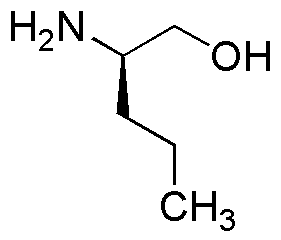D-Norvalinol is widely utilized in research focused on:
- Pharmaceutical Development: It serves as a building block in the synthesis of various pharmaceutical compounds, particularly in the development of drugs targeting neurological disorders.
- Chiral Auxiliary in Organic Synthesis: D-Norvalinol is used as a chiral auxiliary to produce enantiomerically pure compounds, which is crucial in the production of effective drugs with fewer side effects.
- Biochemical Research: Researchers employ it to study protein interactions and enzyme mechanisms, enhancing our understanding of biological processes.
- Flavor and Fragrance Industry: It is utilized in the formulation of flavoring agents and fragrances, providing a unique profile that enhances product appeal.
- Polymer Chemistry: D-Norvalinol can be incorporated into polymer structures, improving material properties for applications in coatings and adhesives.
General Information
Properties
Safety and Regulations
Applications
D-Norvalinol is widely utilized in research focused on:
- Pharmaceutical Development: It serves as a building block in the synthesis of various pharmaceutical compounds, particularly in the development of drugs targeting neurological disorders.
- Chiral Auxiliary in Organic Synthesis: D-Norvalinol is used as a chiral auxiliary to produce enantiomerically pure compounds, which is crucial in the production of effective drugs with fewer side effects.
- Biochemical Research: Researchers employ it to study protein interactions and enzyme mechanisms, enhancing our understanding of biological processes.
- Flavor and Fragrance Industry: It is utilized in the formulation of flavoring agents and fragrances, providing a unique profile that enhances product appeal.
- Polymer Chemistry: D-Norvalinol can be incorporated into polymer structures, improving material properties for applications in coatings and adhesives.
Documents
Safety Data Sheets (SDS)
The SDS provides comprehensive safety information on handling, storage, and disposal of the product.
Product Specification (PS)
The PS provides a comprehensive breakdown of the product’s properties, including chemical composition, physical state, purity, and storage requirements. It also details acceptable quality ranges and the product's intended applications.
Certificates of Analysis (COA)
Search for Certificates of Analysis (COA) by entering the products Lot Number. Lot and Batch Numbers can be found on a product’s label following the words ‘Lot’ or ‘Batch’.
*Catalog Number
*Lot Number
Certificates Of Origin (COO)
This COO confirms the country where the product was manufactured, and also details the materials and components used in it and whether it is derived from natural, synthetic, or other specific sources. This certificate may be required for customs, trade, and regulatory compliance.
*Catalog Number
*Lot Number
Safety Data Sheets (SDS)
The SDS provides comprehensive safety information on handling, storage, and disposal of the product.
DownloadProduct Specification (PS)
The PS provides a comprehensive breakdown of the product’s properties, including chemical composition, physical state, purity, and storage requirements. It also details acceptable quality ranges and the product's intended applications.
DownloadCertificates of Analysis (COA)
Search for Certificates of Analysis (COA) by entering the products Lot Number. Lot and Batch Numbers can be found on a product’s label following the words ‘Lot’ or ‘Batch’.
*Catalog Number
*Lot Number
Certificates Of Origin (COO)
This COO confirms the country where the product was manufactured, and also details the materials and components used in it and whether it is derived from natural, synthetic, or other specific sources. This certificate may be required for customs, trade, and regulatory compliance.


